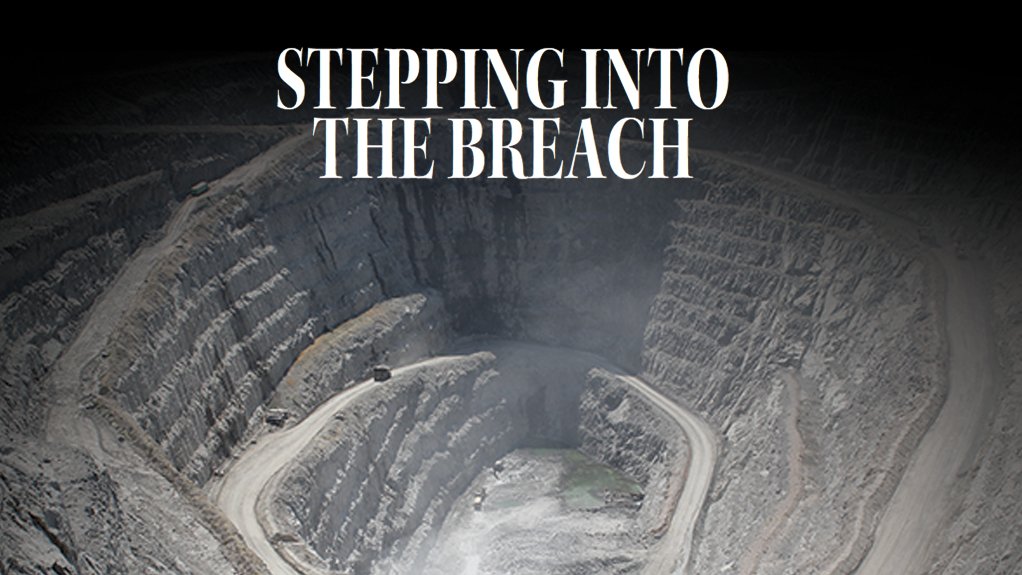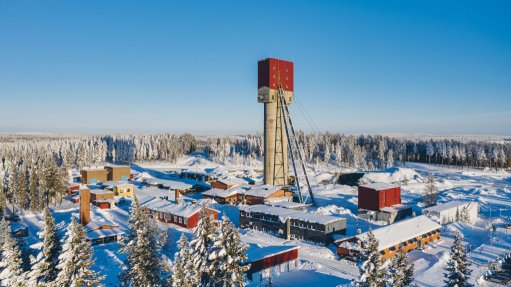Private-equity-backed funders coming to the rescue of mining juniors as capital markets pull in their horns




SANDILE HLOPHE Financial investors and private equity-backed alternative capital providers will be active in the mergers and acquisitions market in the first half of 2014
BRUCE DICKINSON It was difficult for mining majors to get deals done during the back end of 2012 and 2013
There is increased financial investor interest in the junior mining space in emerging markets, especially in Africa, from resource-focused private-equity-investment providers, says professional services firm EY head of transaction advisory services for Africa Sandile Hlophe.
He says financial investors and private equity- backed alternative capital providers, including high-net-worth individuals and investment banks, will be particularly active in the mergers and acquisitions (M&A) market in the first half of 2014, as they will be driven by expected longer-term commodity price recovery and the ability to leverage management ability.
This active involvement can also be attributed to financial investors aiming to build up sizeable resources platforms for an easy exit to strategic majors in the next five to seven years, when the resource market improves and mining majors embark on acquisitive expansion.
“Several private-equity funds have raised resources-focused funds and I expect increased deployment of these funds into resources assets this year. I also estimate that these investors have more than $10-billion in deal capacity for the sector; therefore, some big deals are expected to be made in the sector over the next year,” says Hlophe.
The deals are likely to be focused on low-risk geographies and on leveraging underperforming assets using technical, operational and financial influence to generate better returns.
Private-equity information and analysis firm Pangea Exploration chairperson and CEO Rob Still maintains that private capital funding for junior miners is proving to be the most viable project funding option, as funding for miners through public listing, especially funding for junior miners, has collapsed worldwide.
He said at The African Mining Network’s bimonthly event, held in Johannesburg, last month, that the reason for the collapse of mining capital markets was the breakdown in confidence in the junior mining sector.
“Statistics indicate that 75% of mining initial public offerings (IPOs) over the past few years are failing, while the average loss over the past five years is 30%, with the 2010/11 IPOs trading at an average loss of 50%.”
In addition, capital expenditure overruns are another significant reason for mining capital markets breaking down. Statistics show that, over the past five years, there has been an average of 56% in capital overruns in the mining industry.
“This has a negative influence on the returns of mining projects and could also be the reason for a lack of IPOs and for the crisis in confidence in the junior mining sector,” noted Still.
He added that the implications of the crisis in the mining capital markets would likely result in a declining number of junior miners worldwide, down round financing, as well as mergers and asset sales.
Turnaround
A slowdown in deal volumes and values in the mining industry during 2013 has led to M&A interest and activity in the African junior mining and emerging mining space.
The slowdown has mainly occurred as a result of mining majors – which are under pressure to cut costs and save working capital – aiming to repatriate capital to their mature operations to optimise capital and strengthen their balance sheets for expansion when the market turns and investor confidence returns.
“The mining industry is seeing many majors exit a lot of their divisions to reduce their exposure to emerging market mining because of the current downturn in resource pricing.”
Law firm Webber Wentzel mining transaction partner Bruce Dickinson agrees with this trend, stating that it was difficult for majors to get deals done during the back end of 2012 and 2013, as there was less interest in taking on projects because buyers and sellers could not agree on prices for assets. Projects were also being shut down and were taking longer to complete, owing to a lack of funding.
He says this trend of divesting and repatriating capital has led majors to reassess and optimise their asset portfolio and divest what they deem to be noncore assets.
“This means that many more affordable, smaller-size deals are available for transaction activity on the African continent in the second- tier and junior mining space,” notes Hlophe.
This trend is informed by a common cycle in the resources industry – one during which mining majors re-enter the market in five to seven years’ time, subsequent to exiting, often buying back the asset which they originally sold.
Meanwhile, a further trend that has sparked the emergence of private-equity investment in junior mining projects in the resources market is a reduction in the magnitude of the deals.
Hlophe highlights that private equity was uncommon five years ago, mainly because many M&A deals were often too large and expensive, which meant that only technical players, such as mining houses, could become involved in such large transactions, subsequently leading to junior miners not being able to participate in this market.
The Current Situation
EY’s ‘Mergers, acquisitions and capital raising in mining and metals: 2013 trends, 2014 outlook’ report, released last month, shows that, while deal volumes and value were down 25% and 16% year-on-year to 702 deals (excluding the all-share Xstrata-Glencore merger) and $87.3-billion respectively, a steady improvement in global market conditions should result in a gradual return to deal making in the mining and metals sector in 2014, off the back of a seven-year low in global M&A volumes in 2013.
The report also highlights that 70, or 3%, of the 703 deals worldwide (including the Xstrata-Glencore merger) were Africa-focused, at a deal value of $3.2-billion, of which $1.6-billion constituted deal activity in South Africa.
This $3.2-billion is, however, a decrease of 16% in deal value and a decrease of 2% in deal volume year-on-year in Africa.
Further, the report suggests that Switzerland, the UK and Canada were the top three acquirers of African mining deals in 2013.
The Democratic Republic of Congo was the leading African country in deal value, at $430- million, with South Africa reaching $397-million.
The report also states that copper and gold were the leading target commodities for inbound deals across Africa, while coal was the leading target commodity in South Africa, with 49% of the deals based on value, owing to increased demand for energy in South Africa and other emerging markets.
The resources sector in Africa is receiving significant interest from countries including China, India and Brazil. Many UK- and US-based private-equity firms and investment banks are also aiming to enter the African continent.
Global private-equity investment institution Warburg Pincus, financial services firm JPMorgan and private-equity firm Actis are targeting second-tier and junior miners in Africa, as a result of the current depressed asset prices.
Hlophe believes that the resource- and infrastructure-related and related services-focused private-equity structures that these institutions provide are ideal for Africa, as much of the invest- ment required in the resources space is used to establish much-needed infrastructure for mining projects.
Funding Going Forward
EY expects to see a greater proportion of the mining sector’s funding coming from equity through follow-on raisings during 2014 and a stronger appetite from debt providers, improving access to leveraged loans for high-quality midtier miners and developers.
There were limited IPOs and limited fundraising through public listings last year, and EY expects this trend to continue.
“I expect fewer IPOs to be launched as a means to raise equity in the short term, with more private placements and a lot of project finance- type funding through investment banks,” says Hlophe.
He adds that established miners are trying to obtain most of their capital requirements from private capital, while projects in development are focusing on obtaining finance from funds offered through institutions such as development finance institutions, the International Finance Corporation, the Development Bank of Southern Africa and the World Bank.
Dickinson also believes that specialist funding houses aimed at the resources sector, as well as trading houses and investments by high-net-worth individuals, will be part of the trend going forward.
Resource-Based Private Funding
An example of private equity showing a new interest in mining is the sale of gold major AngloGold Ashanti’s Navachab gold mine, in Namibia, which Dickinson recently advised on, to little-known private company QKR Corporation for $110-million, which will subsequently remove $500-million of operating costs from AngloGold Ashanti’s portfolio.
Navachab, QKR’s first acquisition, is regarded by the company’s president and former Johannesburg gold analyst, Lloyd Pengilly, as having significant potential.
Pengilly left financial services firm JPMorgan in August last year to establish QKR, the major shareholders of which are Qatar Holdings and Kulczyk Investments.
Navachab production comprises less than 2% of AngloGold Ashanti’s total production and is being sold in light of AngloGold wanting to concentrate on larger operations.
AngloGold Ashanti VP Charles Carter, who regards QKR as “the right group to take Navachab forward”, describes the sale as being “fair for value in the midst of a difficult market”.
Comments
Press Office
Announcements
What's On
Subscribe to improve your user experience...
Option 1 (equivalent of R125 a month):
Receive a weekly copy of Creamer Media's Engineering News & Mining Weekly magazine
(print copy for those in South Africa and e-magazine for those outside of South Africa)
Receive daily email newsletters
Access to full search results
Access archive of magazine back copies
Access to Projects in Progress
Access to ONE Research Report of your choice in PDF format
Option 2 (equivalent of R375 a month):
All benefits from Option 1
PLUS
Access to Creamer Media's Research Channel Africa for ALL Research Reports, in PDF format, on various industrial and mining sectors
including Electricity; Water; Energy Transition; Hydrogen; Roads, Rail and Ports; Coal; Gold; Platinum; Battery Metals; etc.
Already a subscriber?
Forgotten your password?
Receive weekly copy of Creamer Media's Engineering News & Mining Weekly magazine (print copy for those in South Africa and e-magazine for those outside of South Africa)
➕
Recieve daily email newsletters
➕
Access to full search results
➕
Access archive of magazine back copies
➕
Access to Projects in Progress
➕
Access to ONE Research Report of your choice in PDF format
RESEARCH CHANNEL AFRICA
R4500 (equivalent of R375 a month)
SUBSCRIBEAll benefits from Option 1
➕
Access to Creamer Media's Research Channel Africa for ALL Research Reports on various industrial and mining sectors, in PDF format, including on:
Electricity
➕
Water
➕
Energy Transition
➕
Hydrogen
➕
Roads, Rail and Ports
➕
Coal
➕
Gold
➕
Platinum
➕
Battery Metals
➕
etc.
Receive all benefits from Option 1 or Option 2 delivered to numerous people at your company
➕
Multiple User names and Passwords for simultaneous log-ins
➕
Intranet integration access to all in your organisation





















